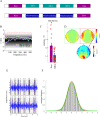Self-regulated critical brain dynamics originate from high frequency-band activity in the MEG
- PMID: 32525940
- PMCID: PMC7289413
- DOI: 10.1371/journal.pone.0233589
Self-regulated critical brain dynamics originate from high frequency-band activity in the MEG
Abstract
Brain function requires the flexible coordination of billions of neurons across multiple scales. This could be achieved by scale-free, critical dynamics balanced at the edge of order and disorder. Criticality has been demonstrated in several, often reduced neurophysiological model systems. In the intact human brain criticality has yet been only verified for the resting state. A more direct link between the concept of criticality and oscillatory brain physiology, which is strongly related to cognition, is yet missing. In the present study we therefore carried out a frequency-specific analysis of criticality in the MEG, recorded while subjects were in a defined cognitive state through mindfulness meditation. In a two-step approach we assessed whether the macroscopic neural avalanche dynamics is scale-free by evaluating the goodness of a power-law fits of cascade size and duration distributions of MEG deflections in different frequency bands. In a second step we determined the closeness of the power-law exponents to a critical value of -1.5. Power-law fitting was evaluated by permutation testing, fitting of alternative distributions, and cascade shape analysis. Criticality was verified by defined relationships of exponents of cascade size and duration distributions. Behavioral relevance of criticality was tested by correlation of indices of criticality with individual scores of the Mindful Attention Awareness Scale. We found that relevant scale-free near-critical dynamics originated only from broad-band high-frequency (> 100 Hz) MEG activity, which has been associated with action potential firing, and therefore links criticality on the macroscopic level of MEG to critical spike avalanches on a microscopic level. Whereas a scale-free dynamics was found under mindfulness meditation and rest, avalanche dynamics shifted towards a critical point during meditation by reduction of neural noise. Together with our finding that during mindfulness meditation avalanches show differences in topography relative to rest, our results show that self-regulated attention as required during meditation can serve as a control parameter of criticality in scale-free brain dynamics.
Conflict of interest statement
The authors have declared that no competing interests exist.
Figures





References
-
- Bak P. How Nature Works. 2nd ed copernicus; 1996.
-
- Shew WL. Neuroscientist The Functional Benefits of Criticality in the Cortex. 2012;(May 2012). - PubMed
Publication types
MeSH terms
Associated data
LinkOut - more resources
Full Text Sources

